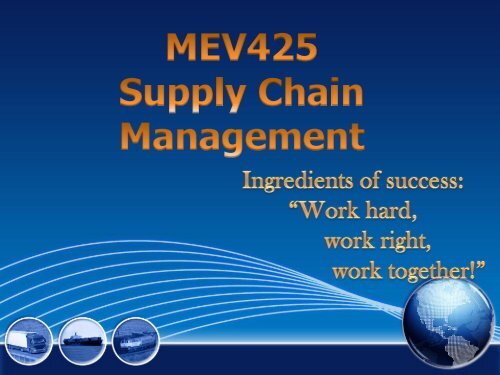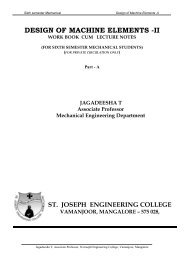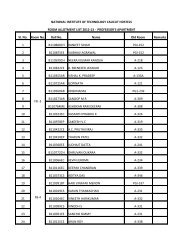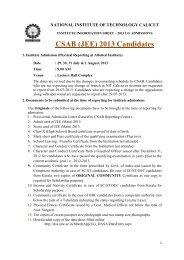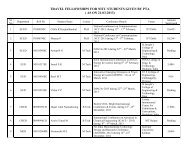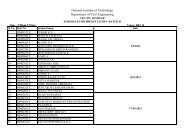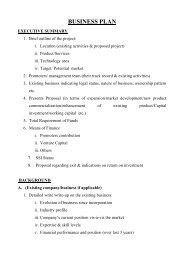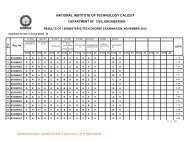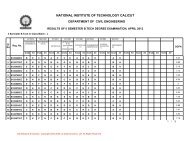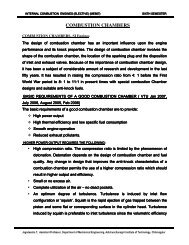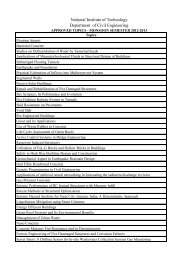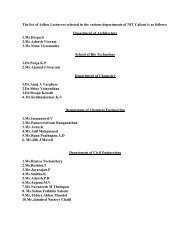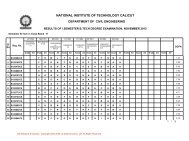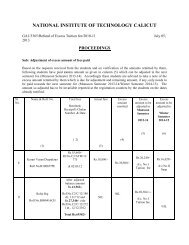Introduction to Operations and Supply Chain Management
Introduction to Operations and Supply Chain Management
Introduction to Operations and Supply Chain Management
Create successful ePaper yourself
Turn your PDF publications into a flip-book with our unique Google optimized e-Paper software.
Lecture Organization<br />
• Lecturing<br />
• Group exercises<br />
• Quizzes/Assignments/Tu<strong>to</strong>rials<br />
• Case discussion<br />
• Case study presentations
Grading Policy<br />
• Grading<br />
◦ Assignment <strong>and</strong> Quiz 10%<br />
◦ Mini-project 10%<br />
◦ Test 1 15%<br />
◦ Test 2 15%<br />
◦ End Exam 50%<br />
• Mini-project<br />
◦ Mini-project in supply chain<br />
◦ Presentation on a relevant <strong>to</strong>pic<br />
on supply chain
Text Books<br />
1. Chopra, S. <strong>and</strong> Meindl, P., <strong>Supply</strong> <strong>Chain</strong> <strong>Management</strong>: Strategy,<br />
Planning <strong>and</strong> Operation, Pearson Education, Inc., Singapore, Second<br />
Edition, 2004.<br />
2. Bozarth, C.C. <strong>and</strong> H<strong>and</strong>field, R. B., <strong>Introduction</strong> <strong>to</strong> <strong>Operations</strong> <strong>and</strong><br />
<strong>Supply</strong> <strong>Chain</strong> <strong>Management</strong>, Pearson Education, 2006.<br />
3. Simchi-Levi, D., Kaminsky, P., Simchi-Levi, E., <strong>and</strong> Ravi Shankar,<br />
Designing <strong>and</strong> Managing the supply chain, Tata McGraw Hill Education<br />
Private Limited, New Delhi, 2008.<br />
4. Shah, J., <strong>Supply</strong> chain management: Text <strong>and</strong> Cases. New Delhi:<br />
Pearson Education, 2009.<br />
5. Shapiro, J.F., Modelling the supply chain, Second Edition, Brooks/Cole,<br />
Cengage Learning, 2007.<br />
6. Dobler, D. W. <strong>and</strong> Burt, D. N., Purchasing <strong>and</strong> <strong>Supply</strong> <strong>Management</strong>:<br />
Text <strong>and</strong> Cases, Sixth Edition, Tata McGraw-Hill Publishing Company<br />
Limited, New Delhi, 1996.<br />
7. Tersine, R. J., Principles of Inven<strong>to</strong>ry <strong>and</strong> Materials <strong>Management</strong>,<br />
Fourth Edition, Prentice-Hall Inc., New Jersey, 1994.
References<br />
1. Chris<strong>to</strong>pher, M., Logistics <strong>and</strong> <strong>Supply</strong> <strong>Chain</strong> <strong>Management</strong>,<br />
Second Edition, Financial Times Professional Limited, 1998.<br />
2. Narasimhan, S. L., McLeavy, D. W. <strong>and</strong> Billing<strong>to</strong>n, P. J.,<br />
Production Planning <strong>and</strong> Inven<strong>to</strong>ry Control, Second Edition,<br />
Prentice Hall of India Private Limited, 1995.<br />
3. Raghuram, G. <strong>and</strong> Rangaraj, N., Logistics <strong>and</strong> <strong>Supply</strong> <strong>Chain</strong><br />
<strong>Management</strong>: Cases <strong>and</strong> Concepts, Macmillan India Limited,<br />
New Delhi, 2000.<br />
4. Arnold, J. R. T. <strong>and</strong> Chapman, S. N., <strong>Introduction</strong> <strong>to</strong> Materials<br />
<strong>Management</strong>, Fourth Edition, Prentice-Hall Inc., 1998.<br />
5. Burt, Dobler <strong>and</strong> Starling, World Class <strong>Supply</strong> <strong>Management</strong>:<br />
Key <strong>to</strong> <strong>Supply</strong> <strong>Chain</strong> <strong>Management</strong>, Tata McGraw-Hill, 7th<br />
Edition, 2003.
<strong>Introduction</strong><br />
• Why study <strong>Supply</strong> <strong>Chain</strong> <strong>Management</strong>?<br />
• <strong>Operations</strong> <strong>Management</strong><br />
• <strong>Supply</strong> <strong>Chain</strong> <strong>Management</strong><br />
• Important trends
Why Study <strong>Operations</strong> <strong>and</strong><br />
<strong>Supply</strong> <strong>Chain</strong> <strong>Management</strong>?
Three Basic Truths<br />
I. Pervasiveness<br />
II.<br />
Interdependence<br />
III. Profitability <strong>and</strong> Survival
1. Pervasiveness<br />
Every organization must make a product or provide<br />
a service that someone values………….<br />
Manufacturer.<br />
Retailer.<br />
Design firm.<br />
University.<br />
Health services.
2. Interdependence<br />
Most organizations function as part of a larger<br />
supply chain<br />
Supplier Manufacturer Distribu<strong>to</strong>r Retailer Cus<strong>to</strong>mer<br />
Upstream<br />
Downstream
<strong>Supply</strong> <strong>Chain</strong>s<br />
• Networks of manufacturers <strong>and</strong> service<br />
providers that work <strong>to</strong>gether <strong>to</strong> move goods from<br />
the raw material stage through <strong>to</strong> the end user<br />
• Linked through physical, information, <strong>and</strong><br />
monetary flows
3. Profitability <strong>and</strong> Survival<br />
Organizations must carefully manage their<br />
operations <strong>and</strong> supply chains <strong>to</strong> prosper, <strong>and</strong><br />
indeed, survive!
<strong>Operations</strong> <strong>Management</strong><br />
THE PLANNING, SCHEDULING,<br />
AND CONTROL OF THE<br />
ACTIVITIES THAT TRANSFORM<br />
INPUTS INTO FINISHED GOODS<br />
AND SERVICES
<strong>Operations</strong> Function<br />
The collection of people, technology, <strong>and</strong> systems<br />
within a company ...<br />
… that has primary responsibility ...<br />
… for providing the organization’s products<br />
<strong>and</strong>/or services.
Viewing <strong>Operations</strong> as a<br />
Transformation Process<br />
Transformation<br />
Process<br />
Manufacturing operations<br />
Inputs<br />
Materials<br />
People<br />
Equipment<br />
Intangible needs<br />
Information<br />
Service operations<br />
Outputs<br />
Tangible goods<br />
Fulfilled requests<br />
Information<br />
Satisfied Cus<strong>to</strong>mers
Manufacturing<br />
• Tangible product<br />
• Key decisions driven by physical<br />
characteristics of the product:<br />
◦ How is the product made?<br />
◦ How do we s<strong>to</strong>re it?<br />
◦ How do we move it?<br />
◦ Etc.
A round watermelon needs lot of room in a refrigera<strong>to</strong>r <strong>and</strong> the usually round<br />
fruit often sits awkwardly on refrigera<strong>to</strong>r shelves. Smart Japanese Farmers have<br />
forced their watermelons <strong>to</strong> grow in<strong>to</strong> a square-shape by inserting the melons<br />
in<strong>to</strong> square, tempered glass cases while the fruit is still growing on the vine.<br />
“Cuboid Watermelon”
Services<br />
• Intangible “Product” or Service<br />
• Key decisions:<br />
◦ How much cus<strong>to</strong>mer involvement?<br />
◦ How much cus<strong>to</strong>mization?
Cross-Functional Linkages<br />
Finance<br />
Budgeting.<br />
Analysis.<br />
Funds.<br />
Design<br />
Sustainability.<br />
Quality.<br />
Manufacturability.<br />
MIS<br />
What IT solutions<br />
<strong>to</strong> make it all work<br />
<strong>to</strong>gether?<br />
<strong>Operations</strong> <strong>and</strong><br />
<strong>Supply</strong> <strong>Chain</strong><br />
Accounting<br />
Performance measurement systems.<br />
Planning <strong>and</strong> control.<br />
Human<br />
Resources<br />
Skills? Training?<br />
# of Employees?<br />
Marketing<br />
What products?<br />
What volumes?<br />
Costs? Quality?<br />
Delivery?
<strong>Supply</strong> <strong>Chain</strong> <strong>Management</strong><br />
ACTIVE MANAGEMENT OF SUPPLY<br />
CHAIN ACTIVITIES AND<br />
RELATIONSHIPS TO MAXIMIZE<br />
CUSTOMER VALUE AND ACHIEVE A<br />
SUSTAINABLE COMPETITIVE<br />
ADVANTAGE
Ancient Times<br />
1904<br />
1960-1975<br />
1975-1990<br />
The first supply chain was the barter system<br />
Traces of outsourcing was seen when Charles S. Rolls<br />
became selling agent for cars made by F. Henry Royce<br />
The essence of SCM was unders<strong>to</strong>od with the first phase<br />
characterized as an inven<strong>to</strong>ry ‘push’ era that focused<br />
primarily on physical distribution of finished goods<br />
Companies began migrating from an inven<strong>to</strong>ry push <strong>to</strong><br />
a cus<strong>to</strong>mer pull channel<br />
1980 Emergence of SCM<br />
1985- WalMart introduced the concept of Cross Docking<br />
1996-<br />
1998-<br />
Internet revolutionized the distribution system of<br />
the business<br />
Concept of e-commerce changed the definition of<br />
business<br />
Module 1:<strong>Supply</strong> <strong>Chain</strong> <strong>Management</strong>
Underst<strong>and</strong>ing the<br />
<strong>Supply</strong> <strong>Chain</strong>
Traditional View: Logistics in the Economy<br />
(1990, 1996)<br />
• Freight Transportation<br />
• Inven<strong>to</strong>ry Expense<br />
• Administrative Expense<br />
• Logistics Related Activity<br />
$352, $455 Billion<br />
$221, $311 Billion<br />
$27, $31 Billion<br />
11%, 10.5% of GNP<br />
Source: Cass Logistics
Traditional View: Logistics in the Manufacturing<br />
Firm<br />
• Profit 4%<br />
• Logistics Cost 21%<br />
• Marketing Cost 27%<br />
Profit<br />
Logistics<br />
Cost<br />
Marketing<br />
Cost<br />
• Manufacturing Cost 48%<br />
Manufacturing<br />
Cost
<strong>Supply</strong> <strong>Chain</strong> <strong>Management</strong>: The Magnitude<br />
in the Traditional View<br />
• Estimated that the grocery industry could save $30<br />
billion (10% of operating cost) by using effective<br />
logistics <strong>and</strong> supply chain strategies<br />
◦ A typical box of cereal spends 104 days from fac<strong>to</strong>ry <strong>to</strong> sale<br />
◦ A typical car spends 15 days from fac<strong>to</strong>ry <strong>to</strong> dealership<br />
• Laura Ashley turns its inven<strong>to</strong>ry 10 times a year, five<br />
times faster than 3 years ago
<strong>Supply</strong> <strong>Chain</strong> <strong>Management</strong>:<br />
The True Magnitude<br />
• Compaq estimates it lost $.5 billion <strong>to</strong> $1 billion in<br />
sales in 1995 because lap<strong>to</strong>ps were not available<br />
when <strong>and</strong> where needed<br />
• P&G estimates that it saved $65 million retail<br />
cus<strong>to</strong>mers by collaboration resulting in a better<br />
match of supply <strong>and</strong> dem<strong>and</strong><br />
• Boeing Aircraft, one of America’s leading capital<br />
goods producers, was forced <strong>to</strong> announce writedowns<br />
of $2.6 billion in Oc<strong>to</strong>ber 1997.<br />
The reason? “Raw material shortages, internal <strong>and</strong> supplier<br />
parts shortages…”. (Wall Street Journal, Oct. 23, 1997)
<strong>Supply</strong> <strong>Chain</strong> <strong>Management</strong>:<br />
The True Magnitude<br />
• SOME ESTIMATES FOR INDIA<br />
* Logistics Spend … IN Rs. 2,40,000 crores<br />
(approx. US $ 50 Billion)<br />
* Share of GDP …….…… 12-13 %<br />
* Major Elements are ( Percentage of Total)<br />
* Transportation ……… 35<br />
* Inven<strong>to</strong>ries ……… 25<br />
* Packaging ……… 11<br />
* H<strong>and</strong>ling & Warehousing ….. 9<br />
* Others & Losses ……… 14
<strong>Supply</strong> <strong>Chain</strong>: The Potential<br />
• In 25 years, NDDB has enabled India <strong>to</strong> become the largest<br />
producer of milk by implementing a logistics <strong>and</strong> supply<br />
chain system that has eliminated several intermediaries,<br />
thereby leading <strong>to</strong> a much higher remunerative price (yield)<br />
for producers <strong>and</strong> lower price for consumers.<br />
• As described in the FORBES magazine, the Dabbawalas of<br />
Mumbai has achieved an extremely high level of reliability<br />
<strong>and</strong> precision (SIX SIGMA level in QA) in delivering <strong>to</strong><br />
their cus<strong>to</strong>mers the products earmarked for them.
<strong>Supply</strong> <strong>Chain</strong>: The Potential<br />
• Dell Computer has outperformed the competition<br />
in terms of shareholder value growth over the<br />
eight years period, 1988-1996, by over 3,000%<br />
using<br />
- Direct business model<br />
- BTO (Build-<strong>to</strong>-Order) strategy.
<strong>Supply</strong> <strong>Chain</strong>: The Potential<br />
• In 10 years, Wal-Mart transformed itself by<br />
changing its logistics system. It has the highest<br />
sales per square foot, inven<strong>to</strong>ry turnover <strong>and</strong><br />
operating profit of any discount retailer.
Outline<br />
• What is a <strong>Supply</strong> <strong>Chain</strong>?<br />
• Decision Phases in a <strong>Supply</strong> <strong>Chain</strong><br />
• Process View of a <strong>Supply</strong> <strong>Chain</strong><br />
• The Importance of <strong>Supply</strong> <strong>Chain</strong> Flows<br />
• Examples of <strong>Supply</strong> <strong>Chain</strong>s
Just a significant evolution…<br />
• Several hundred years ago, Napolean made the<br />
remark, “An army marches on its s<strong>to</strong>mach.”<br />
• Unless the soldiers are fed, the army cannot move.<br />
• Term “supply chain management” arose in the late<br />
1980s <strong>and</strong> came in<strong>to</strong> widespread use in 1990s.<br />
• Prior – ‘Logistics’ <strong>and</strong> ‘operations management’
Some Definitions<br />
<strong>Supply</strong> <strong>Chain</strong> <strong>Management</strong> encompasses every<br />
effort involved in producing <strong>and</strong> delivering a<br />
final product or service, from the supplier’s<br />
supplier <strong>to</strong> the cus<strong>to</strong>mer’s cus<strong>to</strong>mer.<br />
<strong>Supply</strong> <strong>Chain</strong> <strong>Management</strong> includes managing<br />
supply <strong>and</strong> dem<strong>and</strong>, sourcing raw materials <strong>and</strong><br />
parts, manufacturing <strong>and</strong> assembly, warehousing<br />
<strong>and</strong> inven<strong>to</strong>ry tracking, order entry <strong>and</strong> order<br />
management, distribution across all channels,<br />
<strong>and</strong> delivery <strong>to</strong> the cus<strong>to</strong>mer.<br />
The <strong>Supply</strong> <strong>Chain</strong> Council, U.S.A.
Some More Definitions<br />
<strong>Supply</strong> <strong>Chain</strong> <strong>Management</strong> deals with the management of<br />
materials, information, <strong>and</strong> financial flows in a network<br />
consisting of suppliers, manufacturers, distribu<strong>to</strong>rs <strong>and</strong><br />
cus<strong>to</strong>mers.<br />
Stanford <strong>Supply</strong> <strong>Chain</strong> Forum<br />
Logistics involves “managing the flow of items, information,<br />
cash <strong>and</strong> ideas through the coordination of supply chain<br />
processes <strong>and</strong> through the strategic addition of place,<br />
period <strong>and</strong> pattern values.<br />
MIT Center for Transportation <strong>and</strong> Logistics
Some More Definitions<br />
<strong>Supply</strong> <strong>Chain</strong> <strong>Management</strong> is primarily concerned with the efficient<br />
integration of suppliers, fac<strong>to</strong>ries, warehouses <strong>and</strong> s<strong>to</strong>res so that<br />
merch<strong>and</strong>ise is produced <strong>and</strong> distributed in the right quantities, <strong>to</strong> the<br />
right locations <strong>and</strong> at the right time, <strong>and</strong> so as <strong>to</strong> minimize <strong>to</strong>tal system<br />
cost subject <strong>to</strong> satisfying service requirements.<br />
Simchi-Levi<br />
Call it distribution or logistics or supply chain management. By whatever<br />
name, it is the sinuous, gritty, <strong>and</strong> cumbersome process by which<br />
companies move, materials, parts, <strong>and</strong> products <strong>to</strong> cus<strong>to</strong>mers.<br />
Fortune (1994)
What is a <strong>Supply</strong> <strong>Chain</strong>?<br />
• All stages involved, directly or indirectly, in<br />
fulfilling a cus<strong>to</strong>mer request<br />
• Includes manufacturers, suppliers, transporters,<br />
warehouses, retailers, <strong>and</strong> cus<strong>to</strong>mers<br />
• Within each company, the supply chain includes all<br />
functions involved in fulfilling a cus<strong>to</strong>mer request<br />
(product development, marketing, operations,<br />
distribution, finance, cus<strong>to</strong>mer service)
A picture is better than 1000 words!<br />
How many words would be better than 3 pictures?<br />
- A supply chain consists of<br />
Supplier Manufacturer Distribu<strong>to</strong>r Retailer Cus<strong>to</strong>mer<br />
Upstream<br />
Downstream<br />
- Aims <strong>to</strong> Match <strong>Supply</strong> <strong>and</strong> Dem<strong>and</strong>,<br />
profitably for products <strong>and</strong> services<br />
- Achieves<br />
SUPPLY SIDE<br />
DEMAND SIDE<br />
The right<br />
Product<br />
+ + + +<br />
The right<br />
Price<br />
=<br />
+<br />
The right<br />
S<strong>to</strong>re<br />
The right<br />
Quantity<br />
The right<br />
Cus<strong>to</strong>mer<br />
The right<br />
Time<br />
Higher<br />
Profits
Example of a <strong>Supply</strong> <strong>Chain</strong>?<br />
P&G or other<br />
manufacturer<br />
Third<br />
party DC<br />
Supermarket<br />
Cus<strong>to</strong>mer wants<br />
detergent<br />
<strong>and</strong> goes<br />
<strong>to</strong> Supermarket<br />
Plastic<br />
Producer<br />
Tenneco<br />
Packaging<br />
Chemical<br />
manufacturer<br />
(e.g. Oil Company)<br />
Chemical<br />
manufacturer<br />
(e.g. Oil Company)<br />
Paper<br />
Manufacturer<br />
Timber<br />
Industry
1-40<br />
What is a <strong>Supply</strong> <strong>Chain</strong>?<br />
• CUSTOMER is an integral part of any supply chain<br />
• Includes movement of products from suppliers <strong>to</strong><br />
manufacturers <strong>to</strong> distribu<strong>to</strong>rs, but also includes movement<br />
of information, funds, <strong>and</strong> products in both directions<br />
• Probably more accurate <strong>to</strong> use the term “supply network”<br />
or “supply web”<br />
• All stages may not be present in all supply chains<br />
(e.g., no retailer or distribu<strong>to</strong>r for Dell computer)
The <strong>Supply</strong> <strong>Chain</strong><br />
Suppliers Manufacturers Warehouses &<br />
Distribution Centers<br />
41<br />
Cus<strong>to</strong>mers<br />
Material Costs<br />
Transportation<br />
Costs<br />
Manufacturing Costs<br />
Transportation<br />
Costs<br />
Inven<strong>to</strong>ry Costs<br />
Transportation<br />
Costs
The <strong>Supply</strong> <strong>Chain</strong> – Another View<br />
42<br />
Plan Source Make Deliver Buy<br />
Suppliers Manufacturers Warehouses & Cus<strong>to</strong>mers<br />
Distribution Centers<br />
Material Costs<br />
Transportation<br />
Transportation<br />
Costs<br />
Costs<br />
Transportation<br />
Manufacturing Costs Inven<strong>to</strong>ry Costs Costs
What is <strong>Supply</strong> <strong>Chain</strong> <strong>Management</strong> (SCM)?<br />
43<br />
Plan Source Make Deliver Buy<br />
• A set of approaches used <strong>to</strong> efficiently integrate<br />
◦ Suppliers<br />
◦ Manufacturers<br />
◦ Warehouses<br />
◦ Distribution centers<br />
• So that the product is produced <strong>and</strong> distributed<br />
◦ In the right quantities<br />
◦ To the right locations<br />
◦ And at the right time<br />
• System-wide costs are minimized <strong>and</strong><br />
• Service level requirements are satisfied
<strong>Supply</strong> chain flows<br />
Material flow<br />
Information flow<br />
Fund flow
Material Flows<br />
Upstream<br />
Downstream<br />
Second Tier<br />
Supplier<br />
First Tier<br />
Supplier Distribu<strong>to</strong>r Retailer<br />
Alcoa Ball Corp Anheuser-Busch M&M Meijer<br />
Final<br />
cus<strong>to</strong>mers<br />
Transportation companies
Wheat<br />
Flour<br />
Printed<br />
materials<br />
Aluminium<br />
Fiberboard<br />
Praline<br />
Wafers<br />
Multiple<br />
retailers<br />
Chocolate<br />
Confectionery<br />
manufacturer<br />
Packing<br />
Wholesalers<br />
End<br />
cus<strong>to</strong>mers<br />
Others<br />
(hospital etc.)<br />
Creamery<br />
(milk)<br />
Cocoa<br />
beans<br />
Sugar<br />
Vegetable<br />
oil<br />
Cocoa<br />
butter<br />
Lecithin Emulsifiers,<br />
Salt, etc.
Dynamics of Material Flow<br />
Supplier Plant Warehouse Logistics Retailer
Dynamics of Order Flow<br />
Supplier Plant Warehouse Logistics Retailer
<strong>Supply</strong> <strong>Chain</strong> Planning Processes<br />
Material Requirement Planning<br />
Dem<strong>and</strong> Forecasting<br />
Dem<strong>and</strong> Planning<br />
Component<br />
Requirement<br />
Production<br />
Plan<br />
Supplier Plant Warehouse Logistics Retailer<br />
Order <strong>Management</strong>
<strong>Supply</strong> <strong>Chain</strong><br />
Suppliers’<br />
Suppliers<br />
Direct<br />
Suppliers<br />
Producer<br />
Distribu<strong>to</strong>r<br />
Final<br />
Consumer<br />
<strong>Supply</strong> <strong>Chain</strong>:<br />
‣ A sequence of activities<br />
‣ organizations involved in producing<br />
‣ delivering a good or service<br />
1-50
A <strong>Supply</strong> <strong>Chain</strong> for Bread<br />
Stage of Production<br />
Value<br />
Added<br />
Value of<br />
Product<br />
Farmer produces <strong>and</strong> harvests wheat 2.33 2.33<br />
Wheat transported <strong>to</strong> mill 1.24 3.57<br />
Mill produces flour 2.33 5.90<br />
Flour transported <strong>to</strong> baker 1.25 7.15<br />
Baker produces bread 8.35 15.50<br />
Bread transported <strong>to</strong> grocery s<strong>to</strong>re 1.25 16.75<br />
Grocery s<strong>to</strong>re displays <strong>and</strong> sells bread 3.25 20.00<br />
Total Value-Added 20.00<br />
1-51
The Objective of a <strong>Supply</strong> <strong>Chain</strong><br />
• Maximize overall value created<br />
• <strong>Supply</strong> chain value: difference between what the<br />
final product is worth <strong>to</strong> the cus<strong>to</strong>mer <strong>and</strong> the effort<br />
the supply chain expends in filling the cus<strong>to</strong>mer’s<br />
request<br />
• Value is correlated <strong>to</strong> supply chain profitability<br />
(difference between revenue generated from the<br />
cus<strong>to</strong>mer <strong>and</strong> the overall cost across the supply<br />
chain)
1-53<br />
The Objective of a <strong>Supply</strong> <strong>Chain</strong><br />
• Example: Dell receives 30000/- from a cus<strong>to</strong>mer for a<br />
computer (revenue)<br />
• <strong>Supply</strong> chain incurs costs (information, s<strong>to</strong>rage,<br />
transportation, components, assembly, etc.)<br />
• Difference between 30000/- <strong>and</strong> the sum of all of these<br />
costs is the supply chain profit<br />
• <strong>Supply</strong> chain profitability is <strong>to</strong>tal profit <strong>to</strong> be shared across<br />
all stages of the supply chain<br />
• <strong>Supply</strong> chain success should be measured by <strong>to</strong>tal supply<br />
chain profitability, not profits at an individual stage
The Objective of a <strong>Supply</strong> <strong>Chain</strong><br />
• Sources of supply chain revenue: the cus<strong>to</strong>mer<br />
• Sources of supply chain cost: flows of information,<br />
products, or funds between stages of the supply<br />
chain<br />
• <strong>Supply</strong> chain management is the<br />
management of flows between <strong>and</strong> among<br />
supply chain stages <strong>to</strong> maximize <strong>to</strong>tal<br />
supply chain profitability
Cus<strong>to</strong>mer could be an internal<br />
cus<strong>to</strong>mer or an external cus<strong>to</strong>mer<br />
Module 1:<strong>Supply</strong> <strong>Chain</strong> <strong>Management</strong>
Process View of a <strong>Supply</strong> <strong>Chain</strong><br />
• Cycle view: processes in a supply chain are divided<br />
in<strong>to</strong> a series of cycles, each performed at the<br />
interfaces between two successive supply chain<br />
stages<br />
• Push/pull view: processes in a supply chain are<br />
divided in<strong>to</strong> two categories depending on whether<br />
they are executed in response <strong>to</strong> a cus<strong>to</strong>mer order<br />
(pull) or in anticipation of a cus<strong>to</strong>mer order (push)
Cycle I<br />
Supplier<br />
Manufacturer<br />
Cus<strong>to</strong>mer<br />
Retailer<br />
Distribu<strong>to</strong>r<br />
Cycle III<br />
Module 1:<strong>Supply</strong> <strong>Chain</strong> <strong>Management</strong>
Cycle View of <strong>Supply</strong> <strong>Chain</strong>s<br />
Cus<strong>to</strong>mer Order Cycle<br />
Cus<strong>to</strong>mer<br />
Replenishment Cycle<br />
Retailer<br />
Distributer<br />
Manufacturing Cycle<br />
Procurement Cycle<br />
Manufacturer<br />
Supplier
Cycle View of a <strong>Supply</strong> <strong>Chain</strong><br />
• Each cycle occurs at the interface between two<br />
successive stages<br />
• Cus<strong>to</strong>mer order cycle (cus<strong>to</strong>mer-retailer)<br />
• Replenishment cycle (retailer-distribu<strong>to</strong>r)<br />
• Manufacturing cycle (distribu<strong>to</strong>r-manufacturer)<br />
• Procurement cycle (manufacturer-supplier)<br />
• Cycle view clearly defines processes involved <strong>and</strong> the<br />
owners of each process. Specifies the roles <strong>and</strong><br />
responsibilities of each member <strong>and</strong> the desired<br />
outcome of each process.
Push/Pull View of<br />
<strong>Supply</strong> <strong>Chain</strong> Processes<br />
• <strong>Supply</strong> chain processes fall in<strong>to</strong> one of two categories<br />
depending on the timing of their execution relative <strong>to</strong><br />
cus<strong>to</strong>mer dem<strong>and</strong><br />
• Pull: execution is initiated in response <strong>to</strong> a cus<strong>to</strong>mer<br />
order (reactive)<br />
• Push: execution is initiated in anticipation of<br />
cus<strong>to</strong>mer orders (speculative)<br />
• Push/pull boundary separates push processes from<br />
pull processes
Push/Pull View of <strong>Supply</strong> <strong>Chain</strong>s<br />
Procurement,<br />
Manufacturing <strong>and</strong><br />
Replenishment cycles<br />
Cus<strong>to</strong>mer Order<br />
Cycle<br />
PUSH PROCESSES<br />
PULL PROCESSES<br />
Cus<strong>to</strong>mer<br />
Order Arrives
Push View of SCM<br />
A push-based SCM takes longer <strong>to</strong> react <strong>to</strong> the<br />
changing market place<br />
In a push-based supply chain, production decisions<br />
are usually based on long-term forecasts<br />
In push-based strategies, SCM experience<br />
increased transportation costs, high inven<strong>to</strong>ry<br />
levels <strong>and</strong> high manufacturing costs<br />
In a pull-based supply chain, manufacturing is dem<strong>and</strong> driven<br />
so that it is coordinated with actual external cus<strong>to</strong>mer<br />
dem<strong>and</strong> rather than a forecast<br />
Lead-time reduction occurs as the variabilities<br />
are better moni<strong>to</strong>red in pull-based SCM<br />
Pull View of SCM<br />
Pull-based systems are often difficult <strong>to</strong> implement when lead times<br />
are so long that it is impractical <strong>to</strong> react <strong>to</strong> dem<strong>and</strong> information<br />
Module 1:<strong>Supply</strong> <strong>Chain</strong> <strong>Management</strong>
<strong>Supply</strong> <strong>Chain</strong> Integration – Push Strategies<br />
• Classical manufacturing supply chain strategy<br />
• Manufacturing forecasts are long-range<br />
◦ Orders from retailers’ warehouses<br />
• Longer response time <strong>to</strong> react <strong>to</strong> marketplace changes<br />
◦ Unable <strong>to</strong> meet changing dem<strong>and</strong> patterns<br />
◦ <strong>Supply</strong> chain inven<strong>to</strong>ry becomes obsolete as dem<strong>and</strong> for<br />
certain products disappears<br />
• Increased variability (Bullwhip effect) leading <strong>to</strong>:<br />
◦ Large inven<strong>to</strong>ry safety s<strong>to</strong>cks<br />
◦ Larger <strong>and</strong> more variably sized production batches<br />
◦ Unacceptable service levels<br />
◦ Inven<strong>to</strong>ry obsolescence<br />
• Inefficient use of production facilities (fac<strong>to</strong>ries)<br />
◦ How is dem<strong>and</strong> determined? Peak? Average?<br />
◦ How is transportation capacity determined?<br />
• Examples: Au<strong>to</strong> industry, large appliances, others?<br />
63
<strong>Supply</strong> <strong>Chain</strong> Integration – Pull Strategies<br />
• Production <strong>and</strong> distribution are dem<strong>and</strong>-driven<br />
◦ Coordinated with true cus<strong>to</strong>mer dem<strong>and</strong><br />
• None or little inven<strong>to</strong>ry held<br />
◦ Only in response <strong>to</strong> specific orders<br />
• Fast information flow mechanisms<br />
◦ POS data<br />
• Decreased lead times<br />
• Decreased retailer inven<strong>to</strong>ry<br />
• Decreased variability in the supply chain <strong>and</strong> especially at<br />
manufacturers<br />
• Decreased manufacturer inven<strong>to</strong>ry<br />
• More efficient use of resources<br />
• More difficult <strong>to</strong> take advantage of scale opportunities<br />
• Examples: Dell, Amazon<br />
64
Push/Pull View of<br />
<strong>Supply</strong> <strong>Chain</strong> Processes<br />
• Useful in considering strategic decisions relating <strong>to</strong><br />
supply chain design – more global view of how<br />
supply chain processes relate <strong>to</strong> cus<strong>to</strong>mer orders<br />
• The relative proportion of push <strong>and</strong> pull processes<br />
can have an impact on supply chain performance
<strong>Supply</strong> <strong>Chain</strong> Integration – Push/Pull Strategies<br />
• Hybrid of “push” <strong>and</strong> “pull” strategies <strong>to</strong> overcome<br />
disadvantages of each<br />
• Early stages of product assembly are done in a “push” manner<br />
◦ Partial assembly of product based on aggregate dem<strong>and</strong><br />
forecasts (which are more accurate than individual product<br />
dem<strong>and</strong> forecasts)<br />
◦ Uncertainty is reduced so safety s<strong>to</strong>ck inven<strong>to</strong>ry is lower<br />
• Final product assembly is done based on cus<strong>to</strong>mer dem<strong>and</strong> for<br />
specific product configurations<br />
• <strong>Supply</strong> chain timeline determines “push-pull boundary”<br />
“Generic” Product<br />
Push-<br />
Pull<br />
Boundary<br />
“Cus<strong>to</strong>mized” Product<br />
Raw<br />
Materials<br />
Push Strategy<br />
<strong>Supply</strong> <strong>Chain</strong> Timeline<br />
Pull Strategy<br />
End<br />
Consumer<br />
66
Dem<strong>and</strong> Uncertainty<br />
Choosing Between Push/Pull Strategies<br />
Pull<br />
High<br />
Industries where:<br />
• Cus<strong>to</strong>mization is High<br />
• Dem<strong>and</strong> is uncertain<br />
• Scale economies are Low<br />
Industries where:<br />
• Dem<strong>and</strong> is uncertain<br />
• Scale economies are High<br />
• Low economies of scale<br />
Where do the following<br />
industries fit in this<br />
model:<br />
• Au<strong>to</strong>mobile?<br />
Computer<br />
equipment<br />
Furniture<br />
• Aircraft?<br />
• Fashion?<br />
• Petroleum refining?<br />
Industries where:<br />
Industries where:<br />
• Pharmaceuticals?<br />
• Biotechnology?<br />
• Uncertainty is low<br />
• Low economies of scale<br />
• Push-pull supply chain<br />
• St<strong>and</strong>ard processes are the<br />
norm<br />
• Dem<strong>and</strong> is stable<br />
• Scale economies are High<br />
• Medical Devices?<br />
Push<br />
Low<br />
Books, CD’s<br />
Grocery,<br />
Beverages<br />
Low<br />
Economies of Scale<br />
High<br />
Pull<br />
Push<br />
Source: Simchi-Levi<br />
67
Characteristics of Push, Pull <strong>and</strong> Push/Pull Strategies<br />
PUSH<br />
PULL<br />
Objective Minimize Cost Maximize Service Level<br />
Complexity High Low<br />
Focus Resource Allocation Responsiveness<br />
Lead Time Long Short<br />
Processes <strong>Supply</strong> <strong>Chain</strong> Planning Order Fulfillment<br />
Source: Simchi-Levi<br />
68
<strong>Supply</strong> <strong>Chain</strong> Macro Processes in a Firm<br />
• <strong>Supply</strong> chain processes discussed in the two views<br />
can be classified in<strong>to</strong><br />
◦ Cus<strong>to</strong>mer Relationship <strong>Management</strong> (CRM)- interface<br />
between the firm <strong>and</strong> its cus<strong>to</strong>mers<br />
◦ Internal <strong>Supply</strong> <strong>Chain</strong> <strong>Management</strong> (ISCM) – internal <strong>to</strong> the<br />
firm<br />
◦ Supplier Relationship <strong>Management</strong> (SRM) - interface between<br />
the firm <strong>and</strong> its suppliers
Supplier Firm Cus<strong>to</strong>mer<br />
SRM ISCM CRM<br />
• Source<br />
• Negotiate<br />
• Buy<br />
• Design<br />
collaboration<br />
• <strong>Supply</strong><br />
collaboration<br />
• Strategic planning<br />
• Dem<strong>and</strong> planning<br />
• <strong>Supply</strong> planning<br />
• Fulfillment<br />
• Field service<br />
• Market<br />
• Price<br />
• Sell<br />
• Call center<br />
• Order<br />
management<br />
• Integration among the above three macro processes<br />
is critical for effective <strong>and</strong> successful supply chain<br />
management
Decision Phases of a <strong>Supply</strong> <strong>Chain</strong><br />
• <strong>Supply</strong> chain strategy or design<br />
• <strong>Supply</strong> chain planning<br />
• <strong>Supply</strong> chain operation
<strong>Supply</strong> <strong>Chain</strong> Decisions<br />
STRATEGIC<br />
TACTICAL<br />
OPERATIONAL<br />
Procurement<br />
Manufacturing<br />
Distribution<br />
Logistics
<strong>Supply</strong> <strong>Chain</strong> Strategy or Design<br />
• Decisions about the structure of the supply chain <strong>and</strong><br />
what processes each stage will perform<br />
• Strategic supply chain decisions<br />
◦ Locations <strong>and</strong> capacities of facilities<br />
◦ Products <strong>to</strong> be made or s<strong>to</strong>red at various locations<br />
◦ Modes of transportation<br />
◦ Information systems<br />
• <strong>Supply</strong> chain design must support strategic objectives<br />
• <strong>Supply</strong> chain design decisions are long-term <strong>and</strong><br />
expensive <strong>to</strong> reverse – must take in<strong>to</strong> account market<br />
uncertainty
<strong>Supply</strong> <strong>Chain</strong> Planning<br />
• Planning decisions:<br />
◦ Which markets will be supplied from which locations<br />
◦ Planned buildup of inven<strong>to</strong>ries<br />
◦ Subcontracting, backup locations<br />
◦ Inven<strong>to</strong>ry policies<br />
◦ Timing <strong>and</strong> size of market promotions<br />
• Must consider in planning decisions dem<strong>and</strong><br />
uncertainty, exchange rates, competition over the<br />
time horizon
<strong>Supply</strong> <strong>Chain</strong> Operation<br />
• Time horizon is weekly or daily<br />
• Decisions regarding individual cus<strong>to</strong>mer orders<br />
• <strong>Supply</strong> chain configuration is fixed <strong>and</strong> operating<br />
policies are determined<br />
• Goal is <strong>to</strong> implement the operating policies as<br />
effectively as possible<br />
• Allocate orders <strong>to</strong> inven<strong>to</strong>ry or production, set<br />
order due dates, generate pick lists at a<br />
warehouse, allocate an order <strong>to</strong> a particular<br />
shipment, set delivery schedules, place<br />
replenishment orders<br />
• Much less uncertainty (short time horizon)
<strong>Supply</strong> <strong>Chain</strong> Decisions<br />
• Supplier Selection<br />
•Allocation of<br />
Suppliers <strong>to</strong> the<br />
Plants<br />
•Location, Number,<br />
Capacity of Plants<br />
•What Products <strong>to</strong><br />
Produce<br />
•Which Plants <strong>to</strong><br />
Produce them<br />
•Location, Number, Size<br />
of Warehouses<br />
• Mode of Shipment<br />
• Port Selection<br />
• Procurement Policy<br />
•Warehouse Allocation<br />
• Inven<strong>to</strong>ry Decisions<br />
• Manufacturing Policy<br />
• Cus<strong>to</strong>mer Allocation<br />
• Distribution Policy<br />
• Vehicle Routing<br />
• Fleet Size<br />
• Production Schedule<br />
•Scheduling on<br />
Machines<br />
• Finished Goods<br />
Inven<strong>to</strong>ry<br />
• Vehicle Routing<br />
• Workload Balancing<br />
Procurement<br />
Manufacturing<br />
Distribution<br />
Logistics


